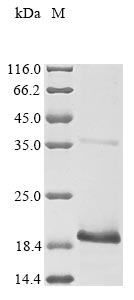Recombinant Human papillomavirus type 6a protein E4 is expressed in E. coli and consists of the full-length protein with an expression region from 1 to 91 amino acids. This product features an N-terminal 10xHis-tag and a C-terminal Myc-tag, which streamlines purification and detection processes. SDS-PAGE analysis indicates a purity level greater than 85%, making it suitable for research applications where high-quality protein is essential.
The E4 protein from Human papillomavirus type 6a appears to play a crucial role in the viral life cycle, particularly in regulating viral replication and modulating cell cycle progression. Research suggests it's significant for understanding viral mechanisms and pathogenesis. Scientists often examine this protein to gain insights into the complex interactions between viral and host cellular components. Studies indicate E4 may be involved in viral assembly and release, which likely contributes to its importance in virology research.
Potential Applications
Note: The applications listed below are based on what we know about this protein's biological functions, published research, and experience from experts in the field. However, we haven't fully tested all of these applications ourselves yet. We'd recommend running some preliminary tests first to make sure they work for your specific research goals.
The recombinant Human papillomavirus type 6a E4 protein (1–91aa, full length) was expressed in E. coli with dual tags (N-terminal 10×His and C-terminal Myc). E4 proteins are small, highly coiled-coil or partially disordered viral regulatory proteins that often require host post-translational modifications or chaperone-mediated folding to reach their native structure. Since E. coli lacks eukaryotic folding machinery and phosphorylation systems involved in E4 regulation, the recombinant form is likely soluble but partially misfolded or lacking proper post-translational features. Therefore, while it may retain some native-like secondary structure, it is unlikely to possess full biological activity or proper conformation identical to viral E4 in host cells. The protein remains, however, useful for antibody generation, immunoassays, and qualitative binding screens where native enzymatic activity is not required.
1. Antibody Development and Validation
The recombinant E4 protein is well-suited for antibody generation. The >85% purity and full-length nature make it appropriate for use as an antigen. If correctly folded, it will induce antibodies recognizing native conformational epitopes. If misfolded, it will still generate antibodies against linear epitopes, suitable for Western blot, ELISA, or immunodetection applications, though not necessarily recognizing native E4 in cells. The dual-tag system aids purification, quantification, and validation of antibody specificity using anti-Myc or anti-His controls.
2. Biochemical Characterization and Structural Studies
While this E4 preparation can be used for basic physicochemical characterization (e.g., CD spectroscopy or DLS), its bacterial origin makes it unsuitable for high-resolution structural or functional assays that require post-translationally modified or folded protein. If partial folding is achieved, secondary structure estimations or stability profiling may still provide useful insights into the intrinsic disorder of E4. However, enzymatic or regulatory function studies are not recommended, as bacterial expression likely prevents proper conformational maturation.
3. ELISA-Based Quantitative Assays
This dual-tagged E4 protein can serve as a standard or positive control in ELISA assays detecting HPV6a E4 antibodies or measuring recombinant protein levels in expression studies. If partially folded, it can be reliably used in quantitative or comparative assays where absolute conformational fidelity is not critical. If misfolded, it may still function as a calibration antigen or assay control, provided that the detection antibodies target linear epitopes or tag sequences. Hence, it remains valuable for assay standardization and detection method validation, but not for functional ELISA studies requiring native-like conformation.






